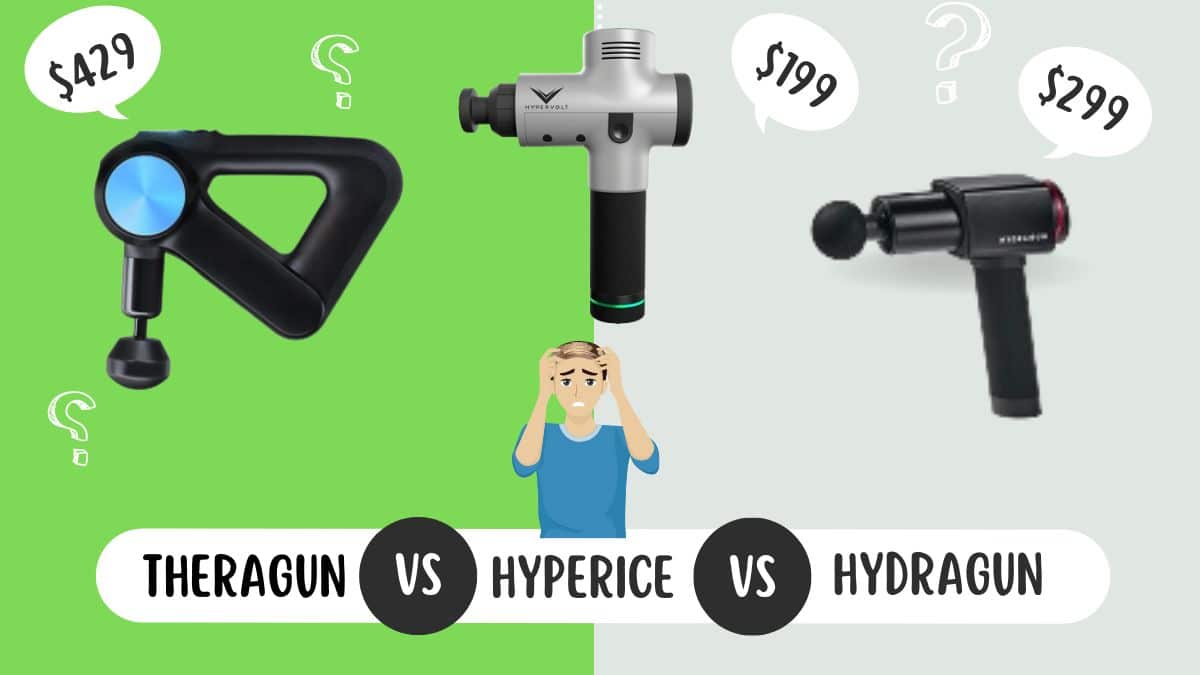
There are so many massage guns on the market right now that it’s head-spinning.
It’s like trying to choose a partner on a dating app. There’s the small and compact one, the bulky and powerful one, the one with the fancy lights, and the one that promises to cure all your aches and pains.
We’ve decided to narrow it down by comparing three of the most popular massage guns in 2025:
Hydragun vs. Theragun vs. Hyperice – which is best for back pain and sciatica?
We’ve decided to compare our Hydragun with the Theragun G3PRO and Hypervolt massage gun to find which one gives the best value for the money.
We’ve compared the versatility, ease of use, noise, battery life, build quality, and consumer reviews.
(This post contains affiliate links, at no extra cost to you)
Overview
Theragun vs. Hydragun vs. Hyperice – Which is Best for Back Pain?
The Theragun Pro is the most powerful massage gun on this list, has the best ergonomics, and is now 55% quieter than previous models. However, it is much more expensive than the Hypervolt and Hydragun, and in our opinion – is not a good choice for people who are not professional athletes.
In comparison, the Hypervolt and Hydragun (costing half the Theragun) are still powerful enough for athletes, yet gentle enough for people suffering from chronic back pain, sciatica, and other back injuries.
Through our research and trial, the best value massage gun for back pain and sciatica is the Hydragun, with 6 speed settings, a quiet operation, a long-lasting battery, and the best carrying case you can find.
It’s a massage gun that fits in the palm of your hand, has enough power to get the job done, and doesn’t break the bank.
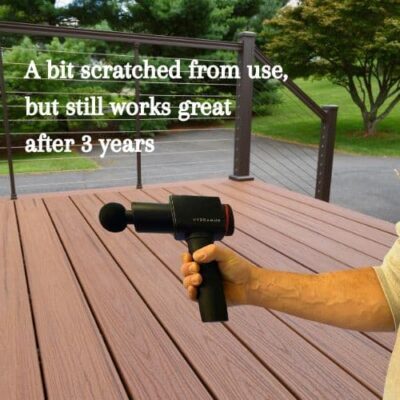
Here’s our full comparison and how we got to this conclusion:
Massage Performance & Strength
The best massage guns should be as light and portable as possible, easy to use, have enough power for deep muscle pain relief (but gentler levels for people with injuries), be easy to carry around, and have a long-lasting battery.
In terms of massage experience, users report that the Theragun G4PRO provides more of a rough, tough, deep tissue beating, whereas the Hypervolt and Hydragun give you a gentler experience, but still work out those tough knots, and allow gradual use for people with injuries and high levels of pain.
The Theragun delivers some of the strongest, deepest percussions on the market, delivering 60 pounds of force in each 16mm punch to penetrate the tissues that even the best masseuses may not reach.
It’s so strong that Theragun suggests a max of two minutes for each area.
However:
We especially like the first two speed levels (out of six) of the Hydragun, which allow for a slower percussion strength, best for people with Sciatica, pinched nerves, and bulging discs.
The Hydragun has six levels to work with. It ranges from 1200 to 3200 RPMs. This allows you to adjust your massage intensity depending on your needs and work your way up gradually.
In comparison, the Theragun goes from 0 to 100 real quick. Not much range for comfort.
Ergonomics & Design
The best ergonomic design belongs to the Theragun, with its donut shape and four arm angles, which make it easy to twist around and reach places that are impossible without outside help.
The hollowed triangle shape allows you to hold it like a bar instead of a handle, and there are 3 different sides you can grip it from to apply pressure from different angles.
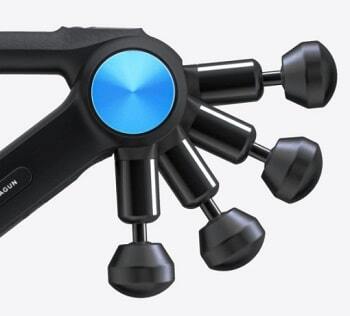
As for the Hypervolt and the Hydragun, Although the design is cool and you can still get to these hard-to-reach areas, they can not reach those further points like the Theragun.
Does this justify hundreds of dollars in price difference? I don’t know, you tell us.
Attachments
The Theragun Pro now has 6 interchangeable heads, including a dampener, standard ball, large ball, wedge, thumb, and cone – all can rotate.
This allows for a large range of massage options – for larger areas and small areas, including hard-to-reach knots between the shoulder blades.
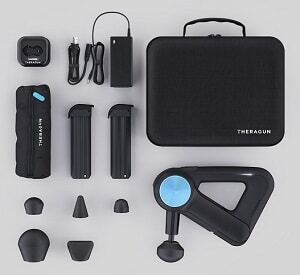
Plus, the Theragun app has a great guide showing you how to work on each muscle group and treat other things like jet lag, morning stiffness, and more.
The Hydragun comes with 6 attachments, and we like the fork attachment, which allows you to work on both sides of the spine – without touching it at all.
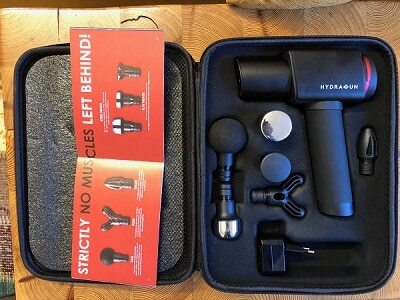
The Hypervolt has 5 attachments – round (to narrow down on pain areas), flat (for denser muscle groups), bullet (trigger points), fork, and Cushion Head – a softer attachment for sensitive areas (great for sensitive people).
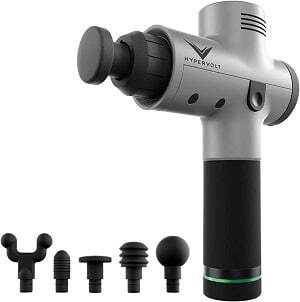
Noise Level
While it seems that Therabody is working on the noise level of their massage guns, with the newest model being 55% quieter, the older models kind of make you feel you are in a construction zone, working with a power drill.
According to consumer reviews, the new PRO4 model is indeed quieter, but still not quiet enough on the higher speed levels – if you plan to use it when someone else is sleeping.
In contrast, the Hypervolt is super quiet, thanks to its Quiet-Glide technology, and the Hydragun is the quietest one of them all.
We use it every day while watching TV at the end of the day, and hardly notice any sound coming out of it.
Battery Life
The Hypervolt battery lasts up to 3 hours on a single charge, the Theragun PRO battery lasts for 2.5 hours (but you get a second battery you can take with you as a replacement), and the Hydragun battery lasts for up to 7 hours on a single charge!
With the Theragun, you’ll need to take that second battery with you if you want it to work for more than 150 minutes.
Carrying Case
In our opinion, the clear winner in this category is the Hydragun, which offers you a lightweight carrying case, designed to fit all its contents.
In comparison, the Theragun carry case only fits the device. The attachment heads come with a separate pouch.
The Hypervolt carrying case costs $49 extra, is sold separately, and only comes with a small pouch for the attachments.
Price, Warranty, and Trial Period
The Theragun Pro is the highest-priced massage gun, and the Hydragun is the lowest-cost one (though the price does not include shipping).
The Hypervolt is mid-priced, but its price does not include shipping.
In our opinion, the Hydragun delivers the most benefits for the money and is best for people suffering from back pain, while the Theragun is most recommended for professional athletes with bigger and less sensitive muscles.
The Hypervolt is a good mid-priced massage gun, but we haven’t found a reason for it to be more expensive than the Hydragun.
Hydragun, Theragun and Hypervolt Pros and Cons
In conclusion, here’s a pros & cons comparison table for Hydragun, Theragun Pro, and Hypervolt:
About Therabody, Hyperice, and Hydragun
Theragun (now Therabody) was founded by Dr. Jason Wersland, who was searching for a tool to help him recover from a motorcycle accident.
It took a few years for him to fine-tune his creation and release the Theragun G1 in 2016.
As of 2025, more than 250 professional sports teams, fitness trainers, and therapists have used the Theragun in more than 40 countries.
The latest Therabody model is the G4PRO, with the signature ergonomic 4-arm design, a quieter motor, and the new Therabody app (with Bluetooth accessibility) – with personalized recovery routines – that integrates with other health apps.
Hyperice is the creator of Hypervolt (still the number one competitor of Therabody) was founded in 2010 and released its first percussive massager (the Raptor) – in 2015.
In 2025, Hyperice products are used by fitness centers, sports teams, and training facilities (including the U.S Air Force Academy) – in over 50 countries.
Hydragun is a relatively new startup, designed by a Muay Thai enthusiast who wanted to improve the too-noisy and too-weak massage guns on the market, for a fair price, by cutting out traditional “middlemen”.
Not sure about the massage gun? Check out our post about the pros and cons of massage guns for back pain!
To your health and happiness,
The Back Pain Relief Products Team

